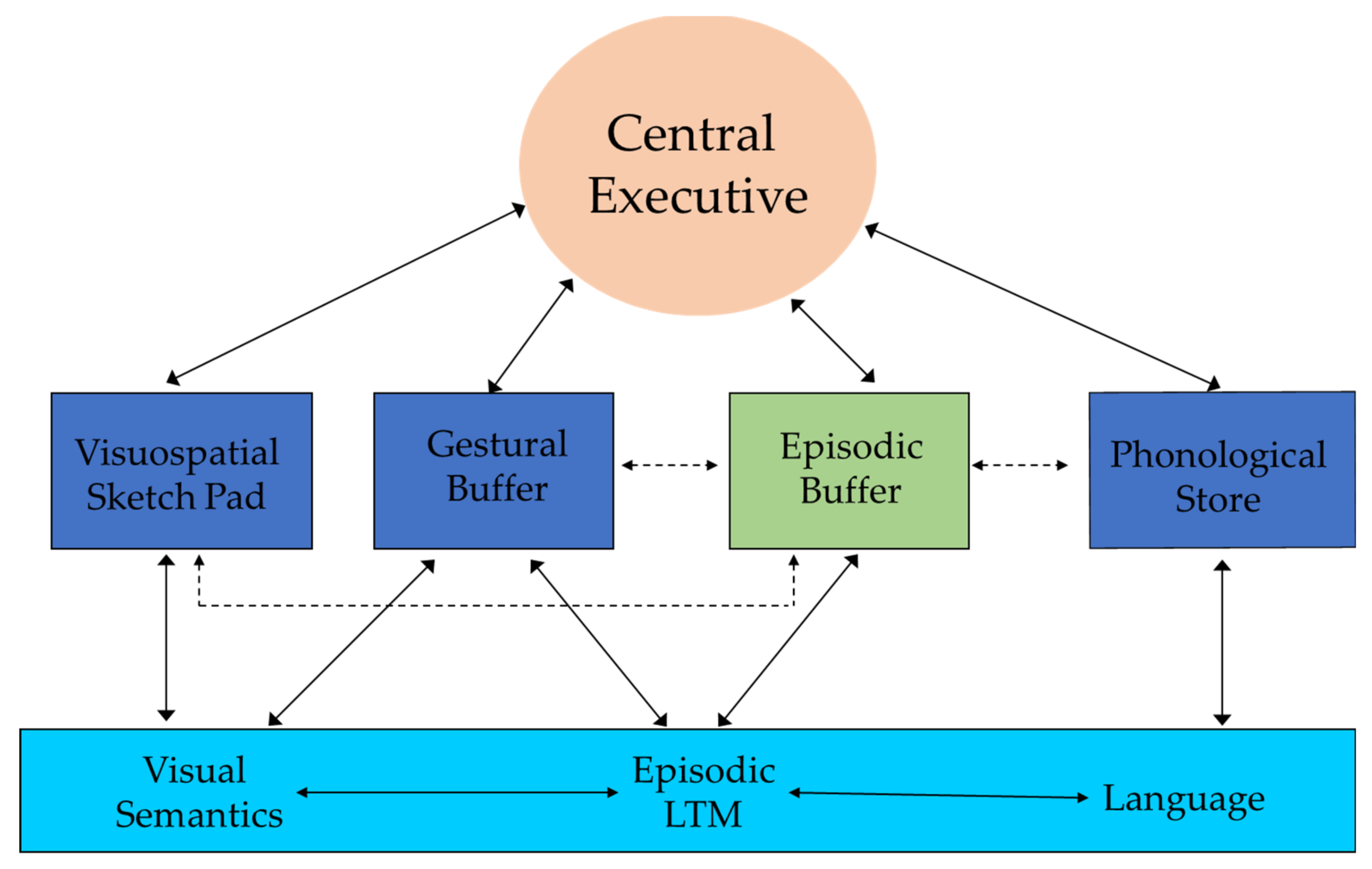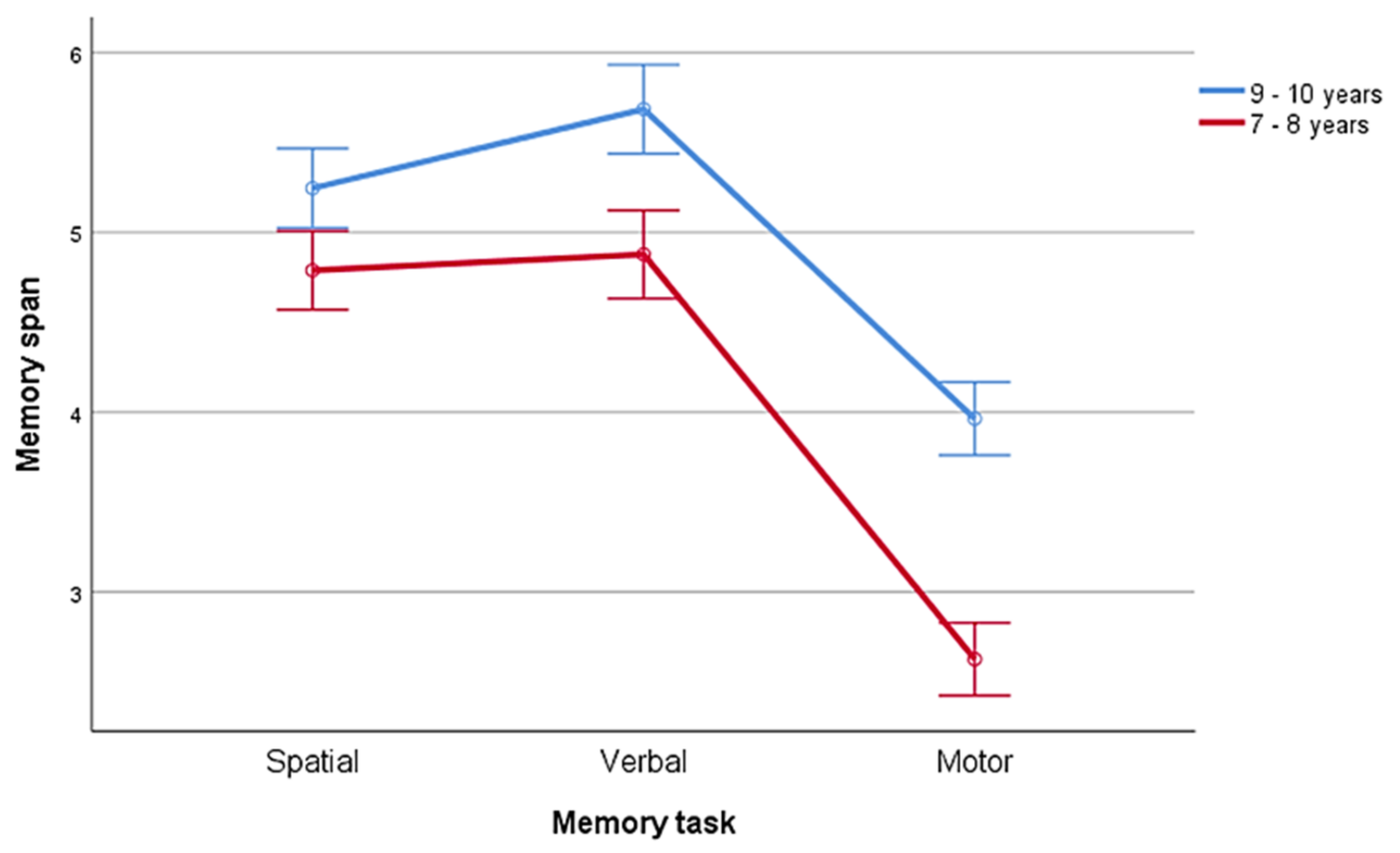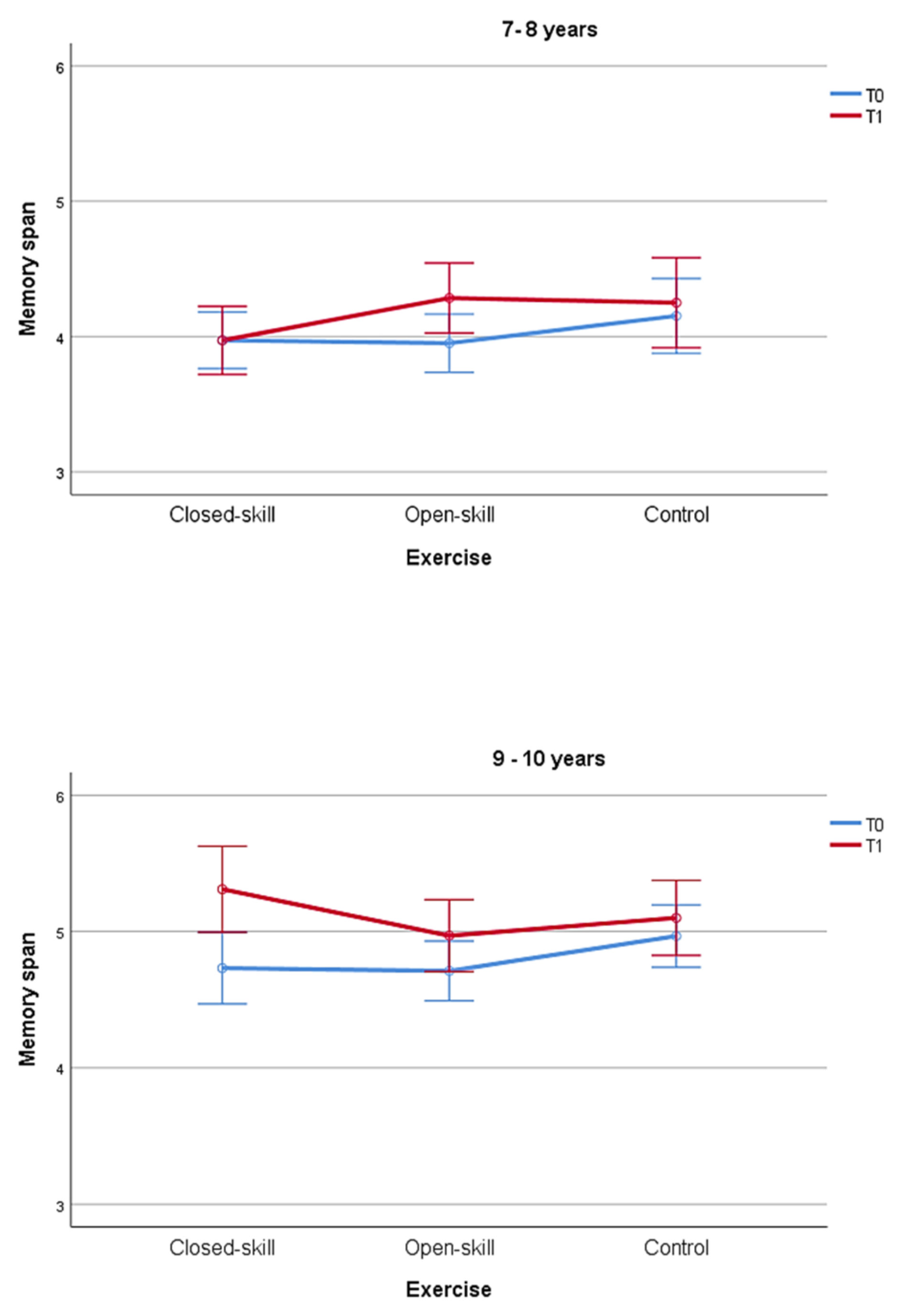The Effect of Structured Exercise on Short-Term Memory Subsystems: New Insight on Training Activities
Abstract
:1. Introduction
2. This Study
3. Method
3.1. Participants
3.2. Ethical Approval
3.3. Design and Procedure
3.4. Statistical Analysis
4. Results
5. Discussion
6. Conclusions
Author Contributions
Funding
Institutional Review Board Statement
Informed Consent Statement
Data Availability Statement
Conflicts of Interest
References
- Biddle, S.J.; Fox, K.; Boutcher, S. Physical Activity and Psychological Well-Being; Routledge: London, UK, 2003. [Google Scholar]
- Ealves, H.; Voss, M.W.; Boot, W.R.; Edeslandes, A.; Ecossich, V.; Salles, J.E.; Kramer, A.F. Perceptual-Cognitive Expertise in Elite Volleyball Players. Front. Psychol. 2013, 4, 36. [Google Scholar] [CrossRef] [Green Version]
- Budde, H.; Voelcker-Rehage, C.; Pietraßyk-Kendziorra, S.; Ribeiro, P.; Tidow, G. Acute coordinative exercise improves attentional performance in adolescents. Neurosci. Lett. 2008, 441, 219–223. [Google Scholar] [CrossRef] [PubMed]
- Ottoboni, G.; Nicoletti, R.; Tessari, A. The Effect of Sport Practice on Enhanced Cognitive Processing of Bod-ily Indices: A Study on Volleyball Players and Their Ability to Predict Hand Gestures. Int. J. Environ. Res. Public Health 2021, 18, 5384. [Google Scholar] [CrossRef]
- Tessari, A.; Lugli, L.; Nicoletti, R.; Ricciardelli, P. Do boxing athletes differ from controls in visually analysing opponent’s postures? A pilot study tracking eye movements. J. Hum. Sport Exerc. 2021, 16, 996. [Google Scholar] [CrossRef]
- Hillman, C.H.; Erickson, K.I.; Kramer, A. Be smart, exercise your heart: Exercise effects on brain and cognition. Nat. Rev. Neur Sci. 2008, 9, 58–65. [Google Scholar] [CrossRef]
- Sibley, B.A.; Beilock, S.L. Exercise and working memory: An individual differences investigation. J. Sport Exerc. Psychol. 2007, 29, 783–791. [Google Scholar] [CrossRef] [PubMed]
- Tomporowski, P.D. Effects of acute bouts of exercise on cognition. Acta Psychol. 2003, 112, 297–324. [Google Scholar] [CrossRef]
- Bidzan-Bluma, I.; Lipowska, M. Physical activity and cognitive functioning of children: A systematic review. Int. J. Environ. Res. Public Health 2018, 15, 800. [Google Scholar] [CrossRef]
- Pesce, C.; Crova, C.; Cereatti, L.; Casella, R.; Bellucci, M. Physical activity and mental performance in preadolescents: Effects of acute exercise on free-recall memory. Ment. Health Phys. Act. 2009, 2, 16–22. [Google Scholar] [CrossRef]
- Ellemberg, D.; St-Louis-Deschênes, M. The effect of acute physical exercise on cognitive function during development. Psychol. Sport Exerc. 2010, 11, 122–126. [Google Scholar] [CrossRef]
- Davis, C.L.; Tomporowski, P.D.; Boyle, C.A.; Waller, J.L.; Miller, P.H.; Naglieri, J.A.; Gregoski, M. Effects of Aerobic Exercise on Overweight Children’s Cognitive Functioning: A Randomized Controlled Trial. Res. Q. Exerc. Sport 2007, 78, 510–519. [Google Scholar] [CrossRef] [PubMed]
- Hinkle, J.S.; Tuckman, B.W.; Sampson, J.P. The Psychology, Physiology, and Creativity of Middle School Aerobic Exercisers. Elem. Sch. Guid. Couns. 1993, 28, 133–145. [Google Scholar]
- Lambrick, D.; Stoner, L.; Grigg, R.; Faulkner, J. Effects of continuous and intermittent exercise on executive function in children aged 8–10 years. Psychophysiol. 2016, 53, 1335–1342. [Google Scholar] [CrossRef] [Green Version]
- Audiffren, M. Acute Exercise and Psychological Functions: A Cognitive-Energetic Approach. In Exercise and Cognitive Function; Wiley: Hoboken, NJ, USA, 2009; pp. 1–39. [Google Scholar]
- McMorris, T.; Sproule, J.; Turner, A.; Hale, B.J. Acute, intermediate intensity exercise, and speed and accuracy in working memory tasks: A meta-analytical comparison of effects. Physiol. Behav. 2011, 102, 421–428. [Google Scholar] [CrossRef] [PubMed]
- Coles, K.; Tomporowski, P.D. Effects of acute exercise on executive processing, short-term and long-term memory. J. Sports Sci. 2008, 26, 333–344. [Google Scholar] [CrossRef]
- Audiffren, M.; Tomporowski, P.D.; Zagrodnik, J. Acute Aerobic exercise and information processing: Energising motor processes during a choice reaction time task. Acta Psychol. 2008, 129, 410–419. [Google Scholar] [CrossRef]
- Singh, A.; Uijtdewilligen, L.; Twisk, J.W.; Van Mechelen, W.; Chinapaw, M.J. Physical activity and performance at school: A systematic review of the literature including a methodological quality assessment. Arch. Pediatr. Adolesc. Med. 2012, 166, 49–55. [Google Scholar] [CrossRef]
- Barenberg, J.; Berse, T.; Dutke, S. Executive functions in learning processes: Do they benefit from physical activity? Educ. Res. Rev. 2011, 6, 208–222. [Google Scholar] [CrossRef]
- Best, J.R. Effects of physical activity on children’s executive function: Contributions of experimental research on aerobic exercise. Dev. Rev. 2010, 30, 331–351. [Google Scholar] [CrossRef] [PubMed]
- Roberts, G.; Quach, J.; Spencer-Smith, M.; Anderson, P.J.; Gathercole, S.; Gold, L.; Sia, K.-L.; Mensah, F.; Rickards, F.; Ainley, J. Academic outcomes 2 years after working memory training for children with low working memory: A randomised clinical trial. JAMA Pediatr. 2016, 170, e154568. [Google Scholar] [CrossRef] [Green Version]
- Chen, K.; Chan, A.H.S. Gerontechnology acceptance by elderly Hong Kong Chinese: A senior technology acceptance model (STAM). Ergonomics 2014, 57, 635–652. [Google Scholar] [CrossRef] [PubMed]
- Kamijo, K.; Pontifex, M.B.; O’Leary, K.C.; Scudder, M.R.; Wu, C.-T.; Castelli, D.M.; Hillman, C.H. The effects of an afterschool physical activity program on working memory in pre-adolescent children. Dev. Sci. 2011, 14, 1046–1058. [Google Scholar] [CrossRef] [Green Version]
- Hötting, K.; Röder, B. Beneficial effects of physical exercise on neuroplasticity and cognition. Neurosci. Biobehav. Rev. 2013, 37, 2243–2257. [Google Scholar] [CrossRef]
- Aronen, E.; Vuontela, V.; Steenari, M.-R.; Salmi, J.; Carlson, S. Working memory, psychiatric symptoms, and academic performance at school. Neurobiol. Learn. Mem. 2005, 83, 33–42. [Google Scholar] [CrossRef]
- Passolunghi, M.C.; Siegel, L.S. Short-Term Memory, Working Memory, and Inhibitory Control in Children with Difficulties in Arithmetic Problem Solving. J. Exp. Child Psychol. 2001, 80, 44–57. [Google Scholar] [CrossRef] [PubMed]
- Baddeley, A. Working Memory. Curr. Biol. 2010, 20, R136–R140. [Google Scholar] [CrossRef] [Green Version]
- Cubelli, R.; Marchetti, C.; Boscolo, G.; Della Sala, S. Cognition in Action: Testing a Model of Limb Apraxia. Brain Cogn. 2000, 44, 144–165. [Google Scholar] [CrossRef] [PubMed] [Green Version]
- Rumiati, R.I.; Tessari, A. Imitation of novel and well-known actions. Exp. Brain Res. 2002, 142, 425–433. [Google Scholar] [CrossRef] [PubMed]
- Tessari, A.; Rumiati, R.I. Motor distal component and pragmatic representation of objects. Cog. Brain Res. 2002, 14, 218. [Google Scholar] [CrossRef]
- Tessari, A.; Rumiati, R.I. The Strategic Control of Multiple Routes in Imitation of Actions. J. Exp. Psychol. Hum. Percept. Perform. 2004, 30, 1107–1116. [Google Scholar] [CrossRef]
- Gu, Q.; Zou, L.; Loprinzi, P.D.; Quan, M.; Huang, T. Effects of open versus closed skill exercise on cognitive function: A systematic review. Front. Psychol. 2019, 10, 1707. [Google Scholar] [CrossRef] [Green Version]
- Tenenbaum, G. Expert athlete: An integrated approach to decision making. In Expert Performance in Sports: Advances in Research on Sport Expertise; Human Kinetics: Champaign, IL, USA, 2003. [Google Scholar]
- Williams, A.M.; Davids, K.; Williams, J.G.P. Visual Perception and Action in Sport; Taylor & Francis: London, UK, 1999. [Google Scholar]
- Huang, C.-J.; Lin, P.-C.; Hung, C.-L.; Chang, Y.-K.; Hung, T.-M. Type of physical exercise and inhibitory function in older adults: An event-related potential study. Psychol. Sport Exerc. 2014, 15, 205–211. [Google Scholar] [CrossRef]
- Piepmeier, A.T.; Etnier, J.L. Brain-Derived Neurotrophic Factor (BDNF) as a potential mechanism of the effects of acute exercise on cognitive performance. J. Sport Health Sci. 2015, 4, 14–23. [Google Scholar] [CrossRef] [Green Version]
- McAllister, A.K.; Katz, L.C.; Lo, D.C. Neurotrophins and synaptic plasticity. Annu. Rev. Neurosci. 1999, 22, 295–318. [Google Scholar] [CrossRef] [Green Version]
- Cao, L.; Liu, X.; Lin, E.-J.D.; Wang, C.; Choi, E.Y.; Riban, V.; Lin, B.; During, M.J. Environmental and genetic activation of a brain-adipocyte bdnf/leptin axis causes cancer remission and inhibition. Cell 2010, 142, 52–64. [Google Scholar] [CrossRef] [Green Version]
- Davis, C.L.; Lambourne, K. Exercise and cognition in children. In Exercise and Cognitive Function; McMorris, T., Tomporowski, P.D., Audiffren, M., Eds.; Wiley: Hoboken, NJ, USA, 2009; pp. 249–267. ISBN 978-0-470-51660-7. [Google Scholar]
- Hung, L.; Au-Yeung, A.; Helmer, C.; Ip, A.; Elijah, L.; Wilkins-Ho, M.; Chaudhury, H. Feasibility and acceptability of an iPad intervention to support dementia care in the hospital setting. Contemp. Nurse 2018, 54, 350–361. [Google Scholar] [CrossRef] [PubMed] [Green Version]
- O’Brien, J.; Ottoboni, G.; Tessari, A.; Setti, A. One bout of open skill exercise improves cross-modal perception and immediate memory in healthy older adults who habitually exercise. PLoS ONE 2017, 12, e0178739. [Google Scholar] [CrossRef] [Green Version]
- Halford, G.S. Information-processing models of cognitive development. In Blackwell Handbook of Childhood Cognitive Development; Goswami, U., Ed.; Blackwell Publishers Ltd.: Malden, MA, USA, 2002; pp. 555–574. ISBN 978-0-470-99665-2. [Google Scholar]
- Wechsler, D. Wechsler Intelligence Scale for Children–Fourth Edition: Technical and Interpretive Manual; Psychological Corporation: San Antonio, TX, USA, 2003. [Google Scholar]
- Milner, B. Interhemispheric differences in the localisation of psychological processes in man. Br. Med. Bull. 1971, 27, 272–277. [Google Scholar] [CrossRef]
- Corsi, P.M. Human memory and the medial temporal region of the brain. Diss. Abstr. Int. 1973, 85, 891. [Google Scholar]
- Tessari, A.; Toraldo, A.; Lunardelli, A.; Zadini, A.; Rumiati, R.I. STIMA: A short screening test for ideo-motor apraxia, selective for action meaning and bodily district. Neurol. Sci. 2015, 36, 977–984. [Google Scholar] [CrossRef] [PubMed] [Green Version]
- Kephart, N.C. The Slow Learner in the Classroom, 2nd ed.; Slow learner Series; Merrill: Columbus, OH, USA, 1971; ISBN 978-0-675-09196-1. [Google Scholar]
- Schofield, W.N. Do Children Find Movements Which Cross the Body Midline Difficult? Q. J. Exp. Psychol. 1976, 28, 571–582. [Google Scholar] [CrossRef]
- Brass, M.; Bekkering, H.; Wohlschläger, A.; Prinz, W. Compatibility between Observed and Executed Finger Movements: Comparing Symbolic, Spatial, and Imitative Cues. Brain Cogn. 2000, 44, 124–143. [Google Scholar] [CrossRef] [PubMed] [Green Version]
- Van der Niet, A.G.; Smith, J.; Scherder, E.J.; Oosterlaan, J.; Hartman, E.; Visscher, C. Associations between daily physical activity and executive functioning in primary school-aged children. J. Sci. Med. Sport 2015, 18, 673–677. [Google Scholar] [CrossRef]
- Wang, M.V.; Lekhal, R.; Aaro, L.E.; Holte, A.; Schjolberg, S. The Developmental relationship between language and motor performance from 3 to 5 years of age: A prospective longitudinal population study. BMC Psychol. 2014, 2, 1–10. [Google Scholar] [CrossRef] [Green Version]
- Roberts, K.L.; Strait, J.A.E.; Decker, S.L. Developmental trajectories of verbal, static visual-spatial, and dynamic visual-spatial working memory. Contemp. Sch. Psychol. 2018, 22, 458–467. [Google Scholar] [CrossRef]
- Gathercole, S.; Pickering, S.J.; Ambridge, B.; Wearing, H. The Structure of working memory from 4 to 15 years of age. Dev. Psychol. 2004, 40, 177–190. [Google Scholar] [CrossRef] [PubMed] [Green Version]
- O’Brien, J.; Ottoboni, G.; Tessari, A.; Setti, A. Multisensory Perception, Verbal, Visuo-spatial and motor working memory modulation after a single open- or closed-skill exercise session in children. J. Cogn. Enhanc. 2021, 5, 141–154. [Google Scholar] [CrossRef]
- Kramer, A.F.; Colcombe, S. Fitness effects on the cognitive function of older adults: A meta-analytic study—Revisited. Perspect. Psychol. Sci. 2018, 13, 213–217. [Google Scholar] [CrossRef] [Green Version]
- Tomporowski, P.D.; Ellis, N.R.; Stephens, R. The immediate effects of strenuous exercise on free-recall memory. Ergonomics 1987, 30, 121–129. [Google Scholar] [CrossRef] [PubMed]
- Tomporowski, P.D.; Ganio, M.S. Short? Term effects of aerobic exercise on executive processing, memory, and emotional reactivity. Int. J. Sport Exerc. Psychol. 2006, 4, 57–72. [Google Scholar] [CrossRef]
- Winter, B.; Breitenstein, C.; Mooren, F.C.; Voelker, K.; Fobker, M.; Lechtermann, A.; Krueger, K.; Fromme, A.; Korsukewitz, C.; Floel, A. High Impact Running Improves Learning. Neurobiol. Learn. Mem. 2007, 87, 597–609. [Google Scholar]
- Best, J.R.; Miller, P.H. A Developmental Perspective on Executive Function. Child. Dev. 2010, 81, 1641–1660. [Google Scholar] [CrossRef] [Green Version]
- Masini, A.; Marini, S.; Gori, D.; Leoni, E.; Rochira, A.; Dallolio, L. Evaluation of school-based interventions of active breaks in primary schools: A systematic review and meta-analysis. J. Sci. Med. Sport 2020, 23, 377–384. [Google Scholar] [CrossRef] [PubMed]
- Diamond, A.; Lee, K. Interventions Shown to Aid Executive Function Development in Children 4 to 12 Years Old. Science 2011, 333, 959–964. [Google Scholar] [CrossRef] [Green Version]
- Masini, A.; Lanari, M.; Marini, S.; Tessari, A.; Toselli, S.; Stagni, R.; Bisi, M.C.; Bragonzoni, L.; Gori, D.; Sansavini, A.; et al. A Multiple Targeted Research Protocol for a Quasi-Experimental Trial in Primary School Children Based on an Active Break Intervention: The Imola Active Breaks (I-MOVE) Study. Int. J. Environ. Res. Public Health 2020, 17, 6123. [Google Scholar] [CrossRef]
- Masini, A.; Marini, S.; Leoni, E.; Lorusso, G.; Toselli, S.; Tessari, A.; Ceciliani, A.; Dallolio, L. Active Breaks: A Pilot and Feasibility Study to Evaluate the Effectiveness of Physical Activity Levels in a School Based Intervention in an Italian Primary School. Int. J. Environ. Res. Public Health 2020, 17, 4351. [Google Scholar] [CrossRef] [PubMed]
- Davis, C.L.; Tomporowski, P.D.; McDowell, J.E.; Austin, B.P.; Miller, P.H.; Yanasak, N.E.; Allison, J.D.; Naglieri, J.A. Exercise Improves Executive Function and Achievement and Alters Brain Activation in Overweight Children: A Randomised, Controlled Trial. Health Psychol. 2011, 30, 91. [Google Scholar] [CrossRef] [PubMed] [Green Version]
- Tomporowski, P.D.; McCullick, B.; Pendleton, D.M.; Pesce, C. Exercise and children’s cognition: The role of exercise characteristics and a place for metacognition. J. Sport Health Sci. 2015, 4, 47–55. [Google Scholar] [CrossRef] [Green Version]



Publisher’s Note: MDPI stays neutral with regard to jurisdictional claims in published maps and institutional affiliations. |
© 2021 by the authors. Licensee MDPI, Basel, Switzerland. This article is an open access article distributed under the terms and conditions of the Creative Commons Attribution (CC BY) license (https://creativecommons.org/licenses/by/4.0/).
Share and Cite
Ottoboni, G.; Ceciliani, A.; Tessari, A. The Effect of Structured Exercise on Short-Term Memory Subsystems: New Insight on Training Activities. Int. J. Environ. Res. Public Health 2021, 18, 7545. https://doi.org/10.3390/ijerph18147545
Ottoboni G, Ceciliani A, Tessari A. The Effect of Structured Exercise on Short-Term Memory Subsystems: New Insight on Training Activities. International Journal of Environmental Research and Public Health. 2021; 18(14):7545. https://doi.org/10.3390/ijerph18147545
Chicago/Turabian StyleOttoboni, Giovanni, Andrea Ceciliani, and Alessia Tessari. 2021. "The Effect of Structured Exercise on Short-Term Memory Subsystems: New Insight on Training Activities" International Journal of Environmental Research and Public Health 18, no. 14: 7545. https://doi.org/10.3390/ijerph18147545
APA StyleOttoboni, G., Ceciliani, A., & Tessari, A. (2021). The Effect of Structured Exercise on Short-Term Memory Subsystems: New Insight on Training Activities. International Journal of Environmental Research and Public Health, 18(14), 7545. https://doi.org/10.3390/ijerph18147545





